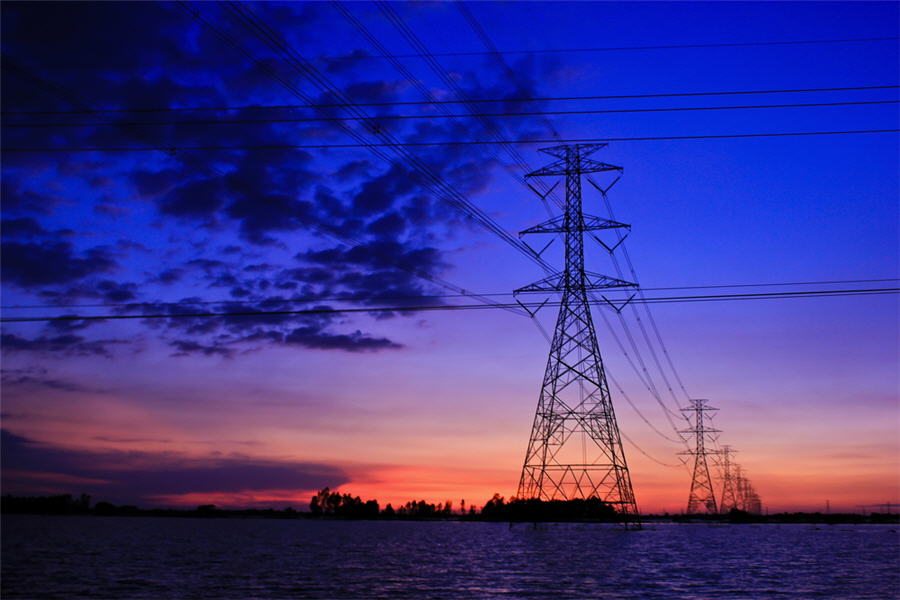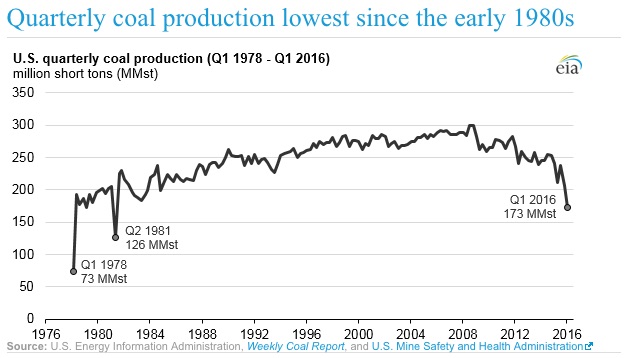
The last time coal production in the United States was this low, Donald Trump was just beginning to build his real estate empire, Ronald Reagan was sworn in as president, and Ordinary People won an Academy Award for best picture. According to the Energy Information Administration, only 173 million tons were produced in the first three months of 2016. The last time that amount of coal was produced, in 1981, there was a good reason for it: the country was in the midst of a major coal strike. Now, culpability for the low numbers comes mostly from a lack of demand, namely, a mild winter that has severely crimped the need to burn the fossil fuel.
“Above-normal temperatures during the winter of 2015–16 were a key reason for the large decrease in coal production during the first three months of 2016. Throughout the fourth quarter of 2015, electric power plants received more coal than they consumed, leading to a net increase of 34 MMst (million short tons) in coal stockpiles, the highest fourth-quarter net increase on record,” the EIA states in a June 10 press release.

Of course there are other factors involved. The administration notes that coal production has declined due to “challenging market conditions for coal producers” – a euphemism for low coal prices – and less environmentally damaging substitutes such as natural gas and renewables.
Among regions, worst-hit was the Powder River Basin, where first-quarter production was just 69 million tons, the lowest level since 1995. In Texas, Michigan, Illinois, and Oklahoma, which together account for 40 percent of the coal market, demand for PRB coal fell to 19 million tons in the first quarter, compared to an average 37 million tons per quarter in 2015.
In January the amount of coal used for electricity generation in the United States sunk to a 45-year low. A graph from the EIA shows coal power generation dipping below 100 million megawatt hours on a monthly basis, with the trend line dropping steadily since 2007. In comparison electricity from natural gas, a substitute fuel for utilities, increased during the same time period, as shale gas production in the U.S. ramped up, causing prices to fall.
Among regions, worst-hit was the Powder River Basin, where first-quarter production was just 69 million tons, the lowest level since 1995.
Along with low prices, the Obama administration’s focus on reducing emissions from coal-powered electricity plants has pushed a number of US producers into bankruptcy protection, including Peabody Energy (NYSE:BTU), the world’s largest privately owned coal producer. The ensuing layoffs have created a battleground in the upcoming presidential election, with the nominee for the Democrats, Hilary Clinton, and presumptive Republican nominee Donald Trump both promising help for displaced coal miners.
During a May speech in North Dakota Trump blasted the current government for over-regulating the industry, saying it needs to “get out of the way” of the industry. If elected Trump said he would “rescind Obama’s “job-destroying” executive actions, “save” the coal industry, revive the Keystone XL pipeline project and cancel the Paris climate accords,” reported CNBC. Hilary Clinton has aimed her criticism at the coal companies for avoiding the responsibility to pay healthcare benefits for retirees during bankruptcy proceedings. Clinton also said she’ll spend more than $30 billion to revitalize communities dependent on coal production, as part of a broader agenda based on switching to clean energy. However Clinton ran afoul of coal-country voters by saying earlier in a televised speech she would put coal companies and miners out of business.
Comments
Altaf
On one side this is a good development for Carbon foot print but it will have a serious indirect effect on the way coal is burned around the world. If US Coal power plants are up and running and expanding, they invest in R&D of efficient power plants like Super Critical thermal & Ultra Super Critical thermal plants. With decrease in Coal power plants, the R&D will come down and this makes the global technology to be stagnant. I am not disrespectful of other national R&D but US leads in this. Just imagine what happens after 20-25 years. China and India will still be using coal for power and the technology remains stagnant at today’s levels.
US will be indirectly responsible for the stagnation of technology development.